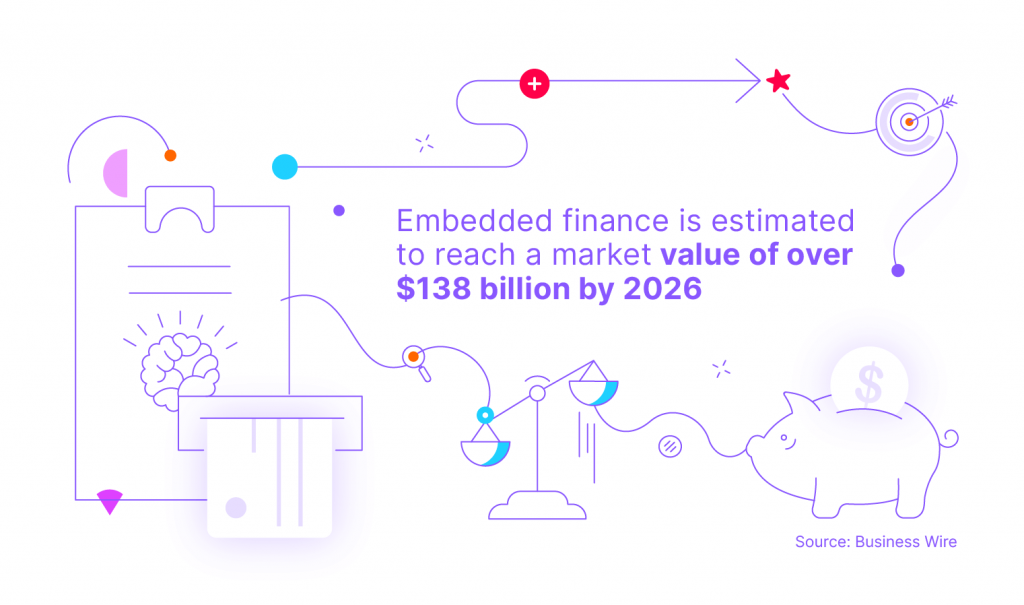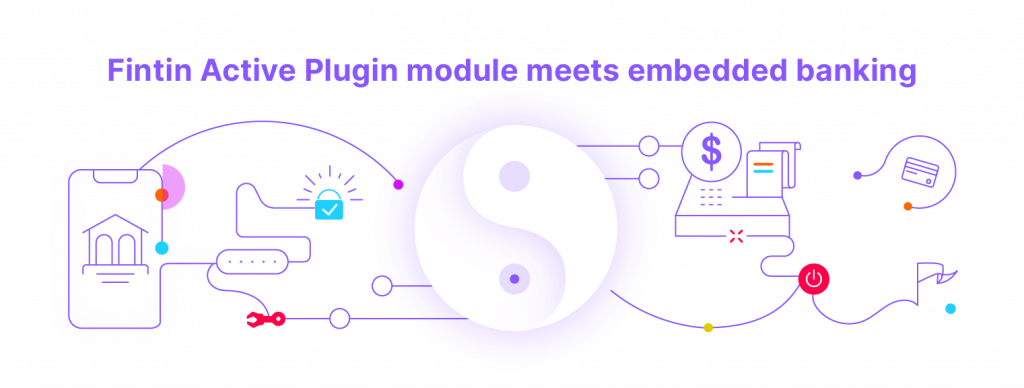How can Embedded Finance revolutionise the banking industry?
- 20.06.2022
- 6 min
Embedded finance is one of the most promising trends that is occurring in the banking industry. Traditional businesses are moving towards digitalization by integrating financial mechanisms into their overall business plan. The era of embedded finance is here, and it’s estimated to reach a market value of over $138 billion in 2026. So, can we say that it’s the beginning of a new financial revolution?
In this article you will find:
What is embedded finance?
Embedded finance integrates loans, insurance, debit cards, and investment instruments with almost any non-financial product. In other words, it means delivering financial services in a business area where the core deal is non-financial. It is essential, for example, in e-commerce services, where the income and customers’ loyalty depend on how fast the transaction is completed.
We’ve seen the growth of embedded finance during the pandemic while most financial processes moved online. As customers became more and more eager to handle all their businesses without leaving the house, the banking sector needed to meet their expectations.
Understanding that embedded finance is a necessary change in providing financial services is a must for the banking sector. They need to be ready to make the switch to this new trend.
Benefits of embedded finance in the banking industry
Embedded finance is essential in developing the future of financial services. Because of various European regulations such as PSD2, financial institutions are moving towards an API economy – partnership and integrated solutions, rather than working separately. Companies that embrace embedded finance will surely benefit from incredibly high customer lifetime value numbers.
Embedded finance allows any financial company to manage and market innovative services. It can seamlessly integrate creative forms of banking products into end-user experiences. It creates new revenue opportunities, increases digital experience, or allows businesses to understand their customers better.
So, let’s take a look at what embedded finance can bring to the banking industry.
Increase customer acquisition
The main benefit of embedded finance for customers is their convenience, as prioritising your end-user became one of the bases of the digital revolution. It should start at the first phase of a company's relationship with customers – onboarding. And if you streamline your onboarding process, you will make it easier to increase customer acquisition.
When your customers are interested in your product, it’s important to make sure that you can speed them through the process and complete it at the earliest possible opportunity. Embedded finance solutions allow them to have an end-to-end interaction with a financial company even through their mobile device.

Customers know what they need. Easy access by any channel and device to the application, relevant updates about the status of financial processes, or total digital transparency are must-haves for the banking industry. Once a company gains a customer, they need to remember to sustain their relationship later.
Enhance customer experience
Making customers happy is as important at later stages of their journey too. With embedded finance, it’s possible to make their digital experience more convenient, for example, because the concept of “payment” almost disappears. As digital payments become the norm, an easy and accessible purchasing experience is important to close a transaction. For online purchasing, embedded finance can shorten the buying journey by making it convenient for customers to complete the transaction without the risk of churning.
Businesses can enhance the ongoing customer experience also with tools such as virtual cards. It can be useful in making returns on previously purchased products. Instead of relying on manually recorded transactions, companies can use a virtual card. This helps customers to claim back their refund simply by entering their card number in any tax refund form or kiosk.
Another example of improving customer experience is in insurance. Embedded finance can include insurance offers while buying a car: It can be easily contracted at the same time and page. Thanks to that, consumers spend less time on boring administrative tasks, and more time in the dream car they bought.
Personalise financing offering
Modern buying experiences, especially in the digital world, rely more and more on providing a personalised experience. With multiple companies offering similar products at similar prices, it’s important to know when and how to offer something to the right customer. It can really make your business grow.
Gathering and analysing your customers’ data is the foundation of a personalised experience. Embedded finance can increase visibility over your customers’ transactions, and let you follow what your customers are looking for and what they buy. It helps you with proposing deals that suit their unique needs.
One of the examples is rewards apps that gather insights into customer purchases. They use it to generate personalised offers and discounts. Once a customer logs in, they can manage their cards, see all future, previous, and outstanding payments, and see what discounts they can use.
Strengthen financing processes’ security
Security is one of the biggest concerns, especially in the banking sector. Whether customers are investing, borrowing, or lending money, it affects the whole decision-making process. Embedded finance offers various security measures, such as integration of “Buy Now, Pay Later” into the system, implementation of real-time monitoring platforms or seamless incorporation of credit products into traditionally non-financial systems.
If embedded finance is effectively implemented, it can create a safe financial space in which everyone has applicable access to comprehensive economic goods and services that are more accessible and better fit their daily lives.
Co-sell financial products easily
Embedded finance can also provide the chance to integrate additional services into the buying experience. By using existing customer information, either provided at checkout or stored in CRM, financial companies can suggest products that are relevant to a selected customer group.
For example, e-commerce platforms not only offer customers the possibility to pay for the selected products as a whole. They can also recommend paying in instalments, which automatically transfers them to the insurer’s offer. Embedded finance makes the whole buying process faster, easier, and without any additional paperwork.
Understand your customers better
Finally, embedded finance allows financial companies to understand their customers better, thus, building meaningful relationships with them. Embedded finance can provide value throughout the whole customer lifecycle by supporting convenience, giving value and important insights.
Fintin meets the new banking trends
Fintin is perfectly flexible to meet the individual needs of financial service providers, car dealers, brokers, and their customers. Our platform meets all the expectations and future trends, and with embedded finance, it was no different. We offer you modules that are a set of flexible financing tools that you can adjust to your specified needs.

One of these modules, called Active Plugin, is designed in line with the embedded finance revolution. You can use our plugin to include your financing services on any website or application. We guarantee that with this addition, you will increase your sales significantly!